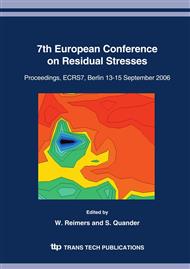p.63
p.71
p.77
p.83
p.89
p.95
p.103
p.109
p.115
Residual Stresses in 3D Sheet Metal Guillotining Using a Coupled Finite Elastoplastic Damage Model
Abstract:
This work deals with the numerical simulation of 3D guillotining of sheet metal using anisotropic elastoplastic model accounting for non-linear isotropic and kinematic hardening fully coupled with isotropic ductile damage and initial residual stresses. Both theoretical and numerical aspects are presented. A 3D finite element model is developed for the numerical simulation of the study state guillotining process. An explicit dynamic resolution strategy is used to solve the associated initial and boundary value problem. Results from the simulation of the guillotining process are given and the influence of residual stresses is investigated.
Info:
Periodical:
Pages:
89-94
Citation:
Online since:
September 2006
Authors:
Price:
Сopyright:
© 2006 Trans Tech Publications Ltd. All Rights Reserved
Share:
Citation:


